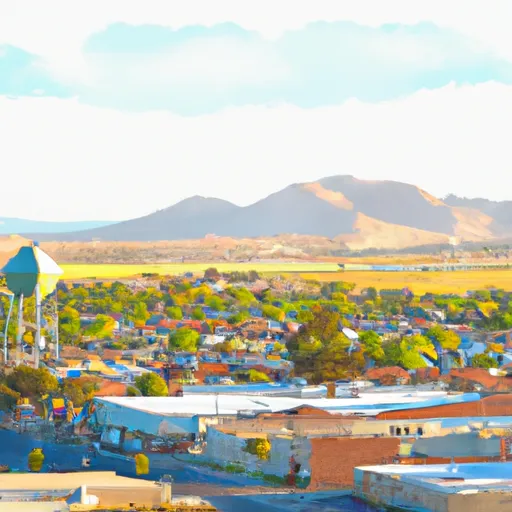-
 Snoflo Premium
Snoflo Premium
Get unlimited access to all our content
With no Ad interruptions! - Start Your Free Trial Login with existing account
Lancaster
Eden Index
Climate
8.5
•
Recreation
3.2
•
Community
2.0
•
Safeguard
5.0/10

Lancaster, California is a city located in the Antelope Valley region of Los Angeles County. Known for its high desert climate, Lancaster experiences hot, dry summers and cool winters. The city's climate is classified as a cold semi-arid desert, with temperatures ranging from an average high of 97°F (36°C) in the summer to lows of 34°F (1°C) in the winter. The strong winds known as the "Santa Ana winds" are a common occurrence in the area.
Regarding hydrology constituents, Lancaster relies heavily on imported water due to the scarcity of local water sources. The city purchases water from the California State Water Project and the Los Angeles Aqueduct.
Lancaster offers numerous outdoor recreation opportunities. The city is surrounded by beautiful desert landscapes and is home to the stunning Antelope Valley California Poppy Reserve, where visitors can enjoy breathtaking displays of wildflowers during the spring. The area also provides opportunities for hiking, camping, and wildlife viewing in the nearby Angeles National Forest and Joshua Tree National Park. Additionally, Lancaster offers golf courses, parks, and recreational facilities for sports enthusiasts.
What is the Eden Index?
The Snoflo Eden Index serves as a comprehensive rating system for regions, evaluating their desirability through a holistic assessment of climate health, outdoor recreation opportunities, and natural disaster risk, acknowledging the profound impact of these factors on livability and well-being.
Climate Health Indicator (CHI): 8.5
Lancaster receives approximately
169mm of rain per year,
with humidity levels near 72%
and air temperatures averaging around
17°C.
Lancaster has a plant hardyness factor of
8, meaning
plants and agriculture in this region tend to thrive here all year round.
By considering the ideal temperature range, reliable water supplies, clean air, and stable seasonal rain or snowpacks, the Climate Health Indicator (CHI) underscores the significance of a healthy climate as the foundation for quality living.
A healthy climate is paramount for ensuring a high quality of life and livability in a region, fostering both physical well-being and environmental harmony. This can be characterized by ideal temperatures, reliable access to water supplies, clean air, and consistent seasonal rain or snowpacks.
Weather Forecast
Streamflow Conditions
Northern Mojave
Area Rivers
Northern Mojave
Snowpack Depths
Northern Mojave
Reservoir Storage Capacity
Northern Mojave
Groundwater Levels
Recreational Opportunity Index (ROI): 3.2
The Recreational Opportunity Index (ROI) recognizes the value of outdoor recreational options, such as parks, hiking trails, camping sites, and fishing spots, while acknowledging that climate plays a pivotal role in ensuring the comfort and consistency of these experiences.
Access to outdoor recreational opportunities, encompassing activities such as parks, hiking, camping, and fishing, is crucial for overall well-being, and the climate plays a pivotal role in enabling and enhancing these experiences, ensuring that individuals can engage in nature-based activities comfortably and consistently.
Camping Areas
| Campground | Campsites | Reservations | Toilets | Showers | Elevation |
|---|---|---|---|---|---|
| Oakwilde | 7 | 1,831 ft | |||
| Chilao | 111 | 5,333 ft | |||
| Antelope Valley Fairgrounds RV Park | 62 | 2,313 ft | |||
| Monte Cristo | 19 | 3,589 ft | |||
| Mt. Pacifico | 9 | 7,092 ft | |||
| Messenger Flats | 10 | 5,793 ft | |||
| Glenn Camp | 8 | 2,095 ft | |||
| Horse Flats | 25 | 5,639 ft | |||
| Devore | 6 | 2,914 ft |
Nearby Fishing
Nearby Ski Areas
Catastrophe Safeguard Index (CSI):
The Catastrophe Safeguard Index (CSI) recognizes that natural disaster risk, encompassing floods, fires, hurricanes, and tornadoes, can drastically affect safety and the overall appeal of an area.
The level of natural disaster risk in a region significantly affects safety and the overall livability, with climate change amplifying these risks by potentially increasing the frequency and intensity of events like floods, fires, hurricanes, and tornadoes, thereby posing substantial challenges to community resilience and well-being.
Community Resilience Indicator (CRI): 2.0
The Community Resilience Indicator (CRI) recognizes that education, healthcare, and socioeconomics are crucial to the well-being of a region. The CRI acknowledges the profound impact of these elements on residents' overall quality of life. By evaluating educational resources, healthcare accessibility, and economic inclusivity, the index captures the essential aspects that contribute to a thriving community, fostering resident satisfaction, equity, and social cohesion.

